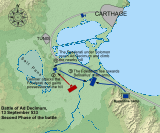Battle of Ad Decimum
| Battle of Ad Decimum | |||||||
|---|---|---|---|---|---|---|---|
| Part of the Vandalic War | |||||||
| |||||||
| Belligerents | |||||||
| Byzantine Empire | Vandal Kingdom | ||||||
| Commanders and leaders | |||||||
| Belisarius | Gelimer | ||||||
| Strength | |||||||
| 15,000 men | 11,000 men | ||||||
| Casualties and losses | |||||||
| Unknown | Unknown | ||||||
The Battle of Ad Decimum took place on September 13, 533 between the armies of the Vandals, commanded by King Gelimer, and the Byzantine Empire, under the command of general Belisarius. This event and events in the following year are sometimes jointly referred to as the Battle of Carthage, one of several battles to bear that name. The Byzantine victory marked the beginning of the end for the Vandals and began the reconquest of the west under the Emperor Justinian I.
Prelude
The Vandal Kingdom in North Africa was ruled by King Hilderic. His reign was noteworthy for the kingdom's excellent relations with the Byzantine Empire ruled by emperor Justinian I. Procopius writes that he was "a very particular friend and guest-friend of Justinian, who had not yet come to the throne", noting that Hilderic and Justinian exchanged large presents of money to each other. Hilderic allowed a new Catholic bishop to take office in the Vandal capital of Carthage, and many Vandals began to convert to Catholicism, to the alarm of the Vandal nobility. Hilderic rejected the Arian Christianity that most Vandals followed. However, in 533, Hilderic was overthrown and killed by his cousin Gelimer. Gelimer began persecuting non Arian Vandals, and many fled to the Byzantine Empire. Justinian sent Byzantine general Belisarius to reconquer the former Roman province of North Africa. The Byzantines would march up the coast to Carthage, the Vandal capital.
Preparation
Ad Decimum (Latin for "Ten Mile Post", literally "at the tenth"), was simply a marker along the Mediterranean coast 10 miles (16 km) south of Carthage. Gelimer, with 11,000 men under his command, had advance warning of the approach of Belisarius' 15,000-man army and chose to take a strong position along the road to Carthage near the post marker. He divided his forces, sending 2,000 men under his nephew Gibamund across a salt pan in an effort to flank Belisarius' army, which was advancing in narrow columns along the road. Another Vandal force, under Gelimer's brother Ammatas, was assigned to initiate a holding action at a defile near Ad Decimum. If everything worked well, Gelimer's 7,000-man main body would follow Gibamund around the Byzantine left flank and cut off their retreat.
Battle
Gibamund failed to accomplish his mission, as a force of Byzantine and Hun mercenaries drove his 2,000-man force off and killed him. Ammatas also failed; he arrived at the defile with his men still strung out along the road back to Carthage, and he too was killed. The Romans pursued his men all the way to the gates of Carthage itself.
Gelimer's main force, however, inflicted serious casualties on the Byzantine troops along the main road. the Byzantine mercenary cavalry was routed by the Vandals, and even though Gelimer was outnumbered, his men were performing well in the fighting. It appeared as though the Vandals would win the battle.
But when Gelimer reached Ammatas's position and discovered that his brother had been killed, by the vanguard of John the Armenian,[1] he became disconsolate and failed to give an order for one more assault — which would probably have destroyed the reeling Roman army and cut off the Huns and Byzantines who had earlier advanced toward Carthage after beating Ammatas and Gibamund. Instead, the Vandal attack was weakened while Gelimer buried his brother on the battlefield. [2]
Given a respite, Belisarius was able to regroup his forces south of Ad Decimum and launch a counterattack, which drove the Vandals back and soon routed them. Gelimer was forced to abandon Carthage.
| Development of the battle | ||||||||
|---|---|---|---|---|---|---|---|---|
|
Aftermath
Belisarius camped near the site of the battle, not wanting to be too close to the city at night. The next day he marched on the city, ordering his men not to kill or enslave the population (as was normal practice at the time) because he stated the people were actually Roman citizens under Vandal rule. They found the gates to the city open, and the army was generally welcomed. Belisarius went straight to the palace and sat on the throne of the Vandal King. He then set about rebuilding the fortifications of the city, and his fleet sought shelter in the Lake of Tunis, five miles (8 km) south of Carthage.
After a second defeat at the Battle of Tricamarum later in the year, the Vandal kingdom was all but ended.
Notes
- ↑ Procopius 2005, p. 9.
- ↑ Beck 2004, p. 1.
References
- Procopius, of Caesarea (2005). "De Bellis" [History of the Wars, Books III and IV]. Gutenberg Project. p. 1. Retrieved 3 July 2013.
- Beck, Sanderson (2004). "Goths, Franks, and Justinian's Empire 476-610". 1worldpeace.org. p. 628. ISBN 0-9717823-8-5. Archived from the original on 3 July 2013. Retrieved 3 July 2013.
Further reading
- Lord Mahon Philip Henry Stanhope, 5th Earl Stanhope, The Life of Belisarius, 1848. Reprinted 2006 (unabridged with editorial comments) Evolution Publishing, ISBN 1-889758-67-1.
Coordinates: 36°45′00″N 10°20′00″E / 36.7500°N 10.3333°E



